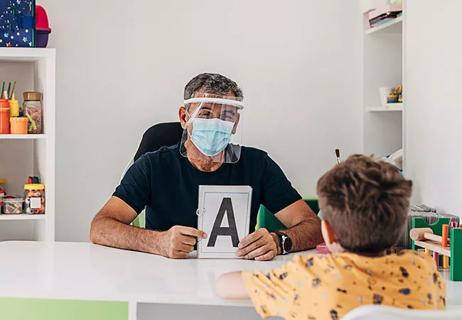New autism risk index may improve evaluation process

Diagnosing autism spectrum disorder (ASD) has long been more art than science. Parent reports, interviews, clinical observation and other mostly subjective methods compose ASD’s diagnostic toolbox.
Cleveland Clinic is a non-profit academic medical center. Advertising on our site helps support our mission. We do not endorse non-Cleveland Clinic products or services. Policy
But now a team from Cleveland Clinic Children’s Center for Autism has developed what may become ASD’s first objective diagnostic aid: an autism risk index based on remote eye-gaze tracking.
“Having a quantitative measure of ASD symptoms could substantially increase the accuracy of clinical diagnosis,” says Thomas Frazier, PhD, Director of Cleveland Clinic Children’s Center for Autism. “And it may help the diagnosis to be accepted more easily by parents wary of relying on clinical impressions alone.”
The feasibility of using remote eye-gaze tracking to diagnose ASD was reported in the April 2016 issue of the Journal of the American Academy of Child and Adolescent Psychiatry.
Abnormal eye gaze and social attention patterns are indicators of ASD. They differentiate ASD from other developmental neuropsychiatric disorders. As such, Dr. Frazier and his team of researchers hypothesized that remote eye-tracking technology could objectively indicate the presence of autism, and possibly its severity.
Unlike earlier versions of eye tracking, which required headgear or even more disruptive methods such as MRI or EEG, remote eye tracking is as comfortable and natural as watching TV. It makes data easy to collect, even from young children. And by using various stimuli, remote eye tracking can gauge attention to various social or nonsocial targets. Fixations on nonsocial stimuli, while a common indicator of ASD, traditionally have been identified only by clinical observation.
In the recent eye-gaze study, Dr. Frazier and his team at Cleveland Clinic Children’s evaluated two samples of children, ages 3 to 8. All had been referred for ASD evaluation by their pediatrician and were subsequently diagnosed as having either ASD or another (non-ASD) developmental disorder, based on clinical consensus.
Researchers (who were blinded to the diagnoses) conducted eye-gaze tracking for each child, using an LCD monitor with a remote eye tracker.
In a quiet, sparse room, children sat alone or on their parent’s lap in front of a monitor on which visual stimuli would appear. Visual stimuli included both photos and videos of “social” subjects, such as an adult with a selection of toys and a child telling a joke, and “nonsocial” subjects, such as inanimate objects and geometric shapes.
Throughout each 7-minute evaluation, the remote eye tracker recorded how long children looked at predefined regions of interest (e.g., faces, body movements). Researchers then averaged looking times, and compared them to standardized looking times of children without ASD, to generate an autism risk index.
“We built the index based on our hypothesis that children with ASD gaze longer at nonsocial targets, like a door hinge, and less at social targets, like a person’s face,” says Dr. Frazier.
The index is a quantitative continuous measure with a mean score of 0. A score of +1.5 indicates borderline risk of ASD; a score of +2.0 indicates elevated risk.
When compared with clinical diagnoses, autism risk index scores were remarkably accurate — even outperforming the SRS-2.
Out of 40 children diagnosed with ASD, the risk index correctly identified 32 (80 percent). Out of 39 children diagnosed with a non-ASD neuropsychiatric disorder, the risk index again correctly identified 32 (82 percent).
The SRS-2 performed at chance levels, with approximately 50 percent accuracy. (However, Dr. Frazier is quick to note that the SRS-2 is intended for screening purposes, and this was an already-screened, high-risk sample.)
The autism risk index also was successful at indicating severity of autism symptoms. In fact, it had a strong correlation with the ADOS-2 (in two samples, .58 and .59), widely regarded as the gold standard in measuring autism symptom severity.
The autism risk index requires further study before it can be validated and scaled for widespread use. However, initial findings are promising.
“We believe eye-gaze tracking is an easy, inexpensive and effective method for helping clinicians identify autism,” says Dr. Frazier. “It can enable earlier diagnosis and, therefore, earlier treatment. This is especially important as the prevalence of autism in the U.S. — currently one in 68 children — continues to grow.”
If additional studies support the autism risk index as sensitive to change, it also could help track effectiveness of ASD treatments, he adds.
“Today, measuring ASD treatment outcomes is even more subjective than diagnosing ASD,” he says. “By removing that subjectivity with a tool like the autism risk index, we could more quickly and easily evaluate current treatments as well as develop new ones.”

Cleveland Clinic physicians offer their insights

Increasing support for breastfeeding patients

Program has facilitated nearly 300 consults across 25 departments in less than a year

Though completely preventable, lead poisoning remains a public health threat

Differences in infection rates, management, outcomes and transmission

Helps patients visualize proper tongue placement

On the need for coordinated care